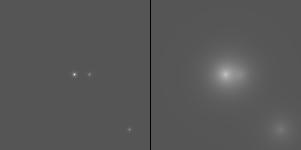Masking:
The visibility of a spatial target is usually reduced by adding background patterns.
Such an effect is called masking. For example, the line segment is easy to
see in a uniform field, but difficult to tell under a noise pattern as shown in
figure 1.
 Fig. 1
Fig. 1
Frequency Masking: Published research results in the literature have
shown that the masking effect is
spatial frequency specific. When the background
patterns, or called maskers, have similar frequency components to the target,
the masking effect is strong. Thus, researchers in this field frequently use
the term spatial frequency masking, and
the effect is explained with spatial frequency channels in the biological visual
system.
In this paragraph we elaborate our way of
thinking about frequency masking. Assuming that the human visual system can perform
image
analysis in a frequency domain
somehow,
a sine-wave is represented by a dot in this domain. Due to spatial inhomogeneities
in the visual system, this dot will spread to its surrounds, producing frequency
components that were not in the original sine-wave. Figure 2 demonstrates the effect
of frequency masking in the frequency domain as an
analogy to the perception in the space domain. The center dot represents
a frequency masker. When there is no frequency spread, the visibility for each of
the two
target dots on its right side is very high (left panel). After adding some spread,
the closer target is barely discriminable, while the far dot is still easy
to tell (right panel).
 Fig. 2
Implicit Masking:
It is well-known from psychophysical experiments that the visibility of a spatial
target is largely determined by the luminance contrast of the target (i.e., the
ratio between the target signal and its background signal strength), but not the
absolute luminance of the target. Along this line, traditional vision models assume
that the early stage of visual processing is to extract luminance contrast of a
visual stimulus as the signal to later visual processing. The potential limitation
with such models is that they would not show the effect of absolute luminance on
visual detection, if there are any. Fig. 2
Implicit Masking:
It is well-known from psychophysical experiments that the visibility of a spatial
target is largely determined by the luminance contrast of the target (i.e., the
ratio between the target signal and its background signal strength), but not the
absolute luminance of the target. Along this line, traditional vision models assume
that the early stage of visual processing is to extract luminance contrast of a
visual stimulus as the signal to later visual processing. The potential limitation
with such models is that they would not show the effect of absolute luminance on
visual detection, if there are any.
Actually, experimentally obtained contrast
thresholds do vary with absolute luminance of the stimuli. For example, Van Nes and Bouman
(1967) studied the change of the contrast threshold of a sinusoidal grating
with its background luminance and spatial frequency. The results showed that the
contrast thresholds are barely affected by the absolute luminance only with coarse
patterns (i.e. low spatial frequencies) at high luminance levels.
What visual functions can be used to simulate
the luminance effects? Yang
and Makous (1994) proposed that the mean luminance level of a stimulus can be treated in the frequency domain along with all other frequency components of the stimulus,
as a component at 0 cpd. As illustrated in figure 2, such a component can act as
a frequency masker to other frequency components, especially to those low frequency
components which are close to the 0 cpd component in the frequency domain.
As the component at 0 cpd is involved in the
very nature of any visual stimulus and is not deliberately intended as a stimulus, its
desensitizing effects is called as implicit masking (Makous,
1997). Based on this thought, the luminance effects are also explained
by frequency masking. With this thought it is easy to describe the change of contrast sensitivity
functions with the luminance level (Yang, Qi, and Makous, 1995). Implicit
masking provides
a coherent framework for developing visual performance
simulators to model and compute luminance-dependent
detection and perception.
References:
Makous, W. L. (1997). Fourier models
and the loci of adaptation. J. Opt. Soc. Am. A, 14, 2323-2345.
Van Nes, F. L. and Bouman, M.A. (1967).
Spatial modulation transfer in the human eye. J. Opt. Soc. A, 57,
401-406.
Yang, J. & Makous, W. (1994). Spatiotemporal
separability in contrast sensitivity. Vision Research, 34, 2569-2576.
Yang, J., Qi, X. & Makous,
W. (1995). Zero frequency masking and a model of contrast sensitivity. Vis.
Res., 35, 1965-1978.
|